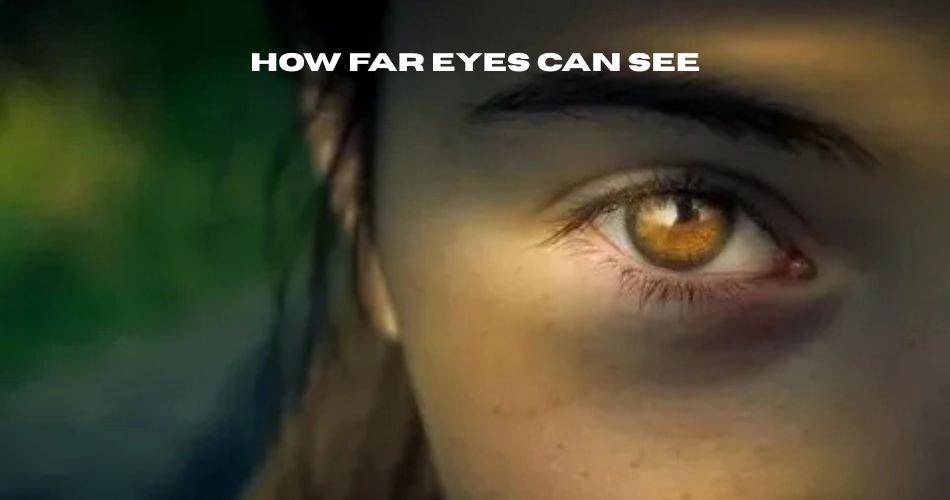When people ask how far the human eye can see, it sounds like a simple question. Yet, answering it isn’t so straightforward. That’s because sight is a deeply complex interaction between biology, physics, and environmental conditions. Our eyes are incredible organs capable of detecting light from stars millions of light-years away. Still, that doesn’t mean we can see objects far across the Earth’s surface just because they’re big or bright. Instead, the real answer depends on a combination of factors—how the eye works, the Earth’s curvature, light conditions, weather, elevation, and even our health. Understanding each of these elements is essential if we want to truly grasp how far our eyes can see in the world around us.
How Vision Works and Why Light Plays the Starring Role in Everything We See
The foundation of all sight is light. Our eyes don’t see objects directly; they see light bouncing off them. That reflected light enters through the cornea, passes through the lens, and focuses onto the retina at the back of the eye. There, millions of tiny photoreceptor cells (rods and cones) interpret the image and send it to the brain via the optic nerve. This whole process happens in milliseconds, but it’s why we can look at a sunset, read a book, or spot an eagle flying above. Without light, the eye simply cannot function—it’s like trying to use a camera in total darkness. The brilliance or dimness of light greatly influences how far we can see. A bright object can be seen from miles away, while a dull one may disappear just a short distance from view.
Why the Curvature of the Earth Is the First Major Limit to How Far Eyes Can See
Even if your eyes are perfect and the weather is crystal clear, the curve of the Earth is a massive physical limitation. The planet isn’t flat, so objects beyond a certain distance drop below your line of sight. For someone of average height (around 6 feet tall) standing at sea level, the horizon appears about 3 miles away. That’s the maximum straight-line distance you can see on a flat plain before the Earth curves out of view. This is why ships appear to sink as they sail away—first the hull disappears, then the masts, and finally the sails. The only way to extend your view is to gain elevation. Climb a mountain, stand on a rooftop, or fly in a plane, and your eyes can reach farther, simply because you’re looking over a wider arc of the Earth’s surface.
Weather and Atmospheric Conditions Have a Huge Influence on Visibility
While the Earth’s curve is one constant limit, atmospheric conditions are constantly changing and can drastically affect how far eyes can see. On a clear day, you might be able to see a distant mountain range over 100 miles away. But introduce a little fog, humidity, dust, smoke, or rain, and visibility drops sharply. The atmosphere scatters light, especially short blue wavelengths, which is why the sky appears blue. However, it also causes distant objects to appear hazy or vanish altogether. This is especially true in humid or polluted areas, where the atmosphere becomes thick with particles that scatter light more aggressively. Even heatwaves rising off pavement can create mirage effects that blur or distort what you see at a distance.
Visual Acuity Is About More Than Just Distance—It’s About Clarity and Focus
Many people mistakenly believe that seeing far means just being able to detect distant shapes. In truth, visual acuity refers to your eye’s ability to distinguish fine details. A person with 20/20 vision can see what an average person sees at 20 feet. But that doesn’t mean they can see far—just clearly. Acuity can vary based on genetics, age, eye health, and even lighting. Someone might be able to see a mountain miles away but only perceive its shape, not its details. Another might see a small bird sharply 50 feet away but miss a massive tower on the horizon due to atmospheric distortion or lighting. So when we ask how far our eyes can see, we also need to ask how well they can see that far.
Mountains, Towers, and the Magic of Height That Extends the Horizon
Elevation is the ultimate cheat code when it comes to increasing your line of sight. The higher you go, the farther you can see. This is why mountaintops offer such breathtaking panoramic views. At 10,000 feet above sea level, your visual horizon stretches more than 120 miles in every direction if the weather is favorable. Pilots often enjoy views of distant cities or mountain ranges from commercial aircraft cruising at 35,000 feet, where the horizon can extend over 250 miles. That kind of visibility is only possible because of altitude. From higher vantage points, your line of sight can arch over the curvature of the Earth and stretch much farther than it can at ground level.
Yes, You Can See Stars That Are Millions of Light-Years Away, But Not a Building 20 Miles Off
This fact seems strange at first. how far eyes can see a star that’s millions of light-years away, yet not a skyscraper just 100 miles away? The answer lies in what you’re seeing. Stars are self-illuminating, emitting intense light that travels unblocked through space. On a clear, dark night, this light hits your retina directly, often without the atmospheric pollution of Earth interfering. On the other hand, buildings reflect light rather than emit it, and their visibility is restricted by Earth’s curve, haze, and light scatter. The Andromeda Galaxy, which is visible to the naked eye in dark skies, is over 2.5 million light-years away. That’s a mind-boggling distance, but it appears as a faint blur because the light it emits is just strong enough to reach us after traveling through space for millions of years.
Binoculars, Telescopes, and Cameras Show Us What Our Eyes Alone Cannot
The human eye is amazing, but it’s not a telescope. That’s where tools like binoculars and lenses come in. These devices gather more light and magnify distant objects, allowing us to see far beyond our natural limits. Binoculars are great for observing wildlife, distant landscapes, or celestial bodies. Telescopes take things a step further, letting us observe planets, moons, and even galaxies that are otherwise invisible. These tools don’t change your eyes—they just extend them by altering how light is collected and focused. With the right gear, the universe opens up far beyond what the naked eye can see.
Wildlife Like Eagles Have Eyes That Can See Farther Than Any Human
Nature always seems to outdo us, and vision is no exception. Birds of prey, especially eagles, have some of the sharpest vision in the animal kingdom. An eagle can spot a rabbit from over two miles away. That’s because their eyes are much larger relative to their body, and they have a higher density of photoreceptors in their retinas. Some birds even see ultraviolet light, which helps them track prey trails. In contrast, the human eye has evolved for balance between near and far vision, color detection, and low-light performance. While we may not beat the eagle in a staring contest, we do have more balanced, adaptable vision overall.
Why You See Less in the City Than in the Countryside
Ever tried stargazing in a big city? You probably saw very few stars, maybe none. That’s due to light pollution. Artificial light from street lamps, buildings, and vehicles floods the atmosphere, drowning out faint natural light from the sky. Add in smog and dust from urban activity, and visibility drops even further. In contrast, rural or remote areas with low light pollution offer a much clearer view of the night sky and even distant landscapes during the day. It’s one of the reasons why national parks and mountaintop observatories are popular with photographers and astronomers alike.
Our Eyes Aren’t Always Honest—Optical Illusions Can Fool Us Into Seeing Farther
Sometimes, the eye sees things that aren’t really there—or at least not where we think. Mirage effects, caused by layers of hot and cool air, can make distant objects appear closer or farther than they are. Refraction, the bending of light through layers of air, can distort the size or position of things like stars, the moon, or ships on the ocean. Even the atmosphere itself can warp what we see. These tricks don’t mean our eyes are broken; they’re just operating based on light’s behavior under unusual conditions.
Aging Eyes Don’t See as Far or as Clearly as They Used To
As we age, our vision naturally declines. The eye’s lens becomes stiffer, the retina less sensitive, and conditions like cataracts, glaucoma, or macular degeneration can set in. This all contributes to a loss in visual acuity, particularly at longer distances. That’s why older adults may struggle to read road signs or spot distant objects even if their vision was sharp in youth. Regular eye checkups, proper lighting, and good nutrition can help slow this decline, but it’s an unavoidable part of aging for most people.
Debunking the Myth That You Can See a Candle Flame From 30 Miles Away
One popular claim is that the human eye can detect a candle flame from 30 miles away. It’s a fun idea, but it’s not based in reality. Even under ideal conditions—no atmospheric interference, total darkness, and perfect vision—a candle flame would be too dim to distinguish at such a range. Studies show the maximum distance for spotting a candle with the naked eye is around 1.5 to 3 miles. Beyond that, the light becomes too scattered and faint. It’s a myth that sounds good but falls apart under scientific scrutiny.
Conclusion
In the end, the question how far eyes can see? opens up an incredible exploration of vision, science, and the natural world. The truth is, there is no single distance that defines human sight. On Earth, your view is capped by the planet’s curvature and atmospheric conditions, often around 3 miles at sea level or much farther from higher elevations. With the help of tools, that distance increases dramatically. In space, your eyes can receive light from objects millions of light-years away. But vision isn’t just about distance—it’s about clarity, brightness, focus, and context. Our eyes are amazing, but they operate within a system of limits and possibilities shaped by light, biology, and the physical world.






